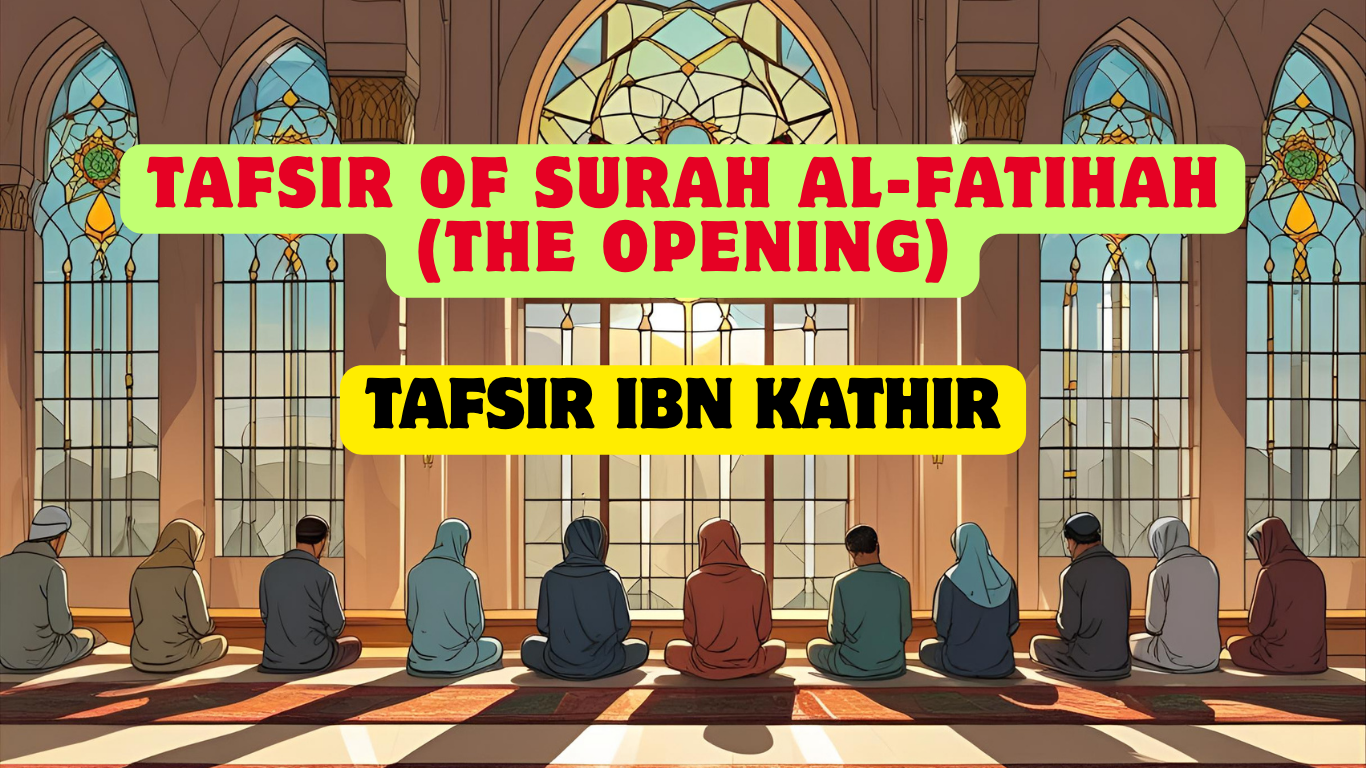Below Is a Formal and Concise Tafsir (Exegesis) of Surah Al-Fatihah (the Opening), the First Chapter of the Qur’an, Based on Classical Islamic Scholarship and Widely Accepted Interpretations. the Explanation Adheres to a Professional Tone, Providing Clear and Structured Insights Into the Meaning, Context, and Significance of the Surah While Remaining Respectful and Thorough.
Tafsir of Surah Al-Fatihah (the Opening)
Surah Al-Fatihah Is the First Chapter of the Qur’an, Consisting of Seven Verses. It Is Also Known As Umm Al-Kitab (the mother of the Book), As-Sab‘Al-Mathani (the Seven Oft-Repeated Verses), and Al-Hamd (the Praise). It Holds a Unique Position in Islamic Theology and Practice, As It Is Recited in Every Unit of the Muslim Prayer (Salah) and Is Considered a Comprehensive Summary of the Qur’an’s Core Themes.
Context and Significance.
Revelation: Surah Al-Fatihah Was Revealed in Makkah (According to Most Scholars, Though Some Suggest Parts Were Revealed in Madinah). It Is the First Complete Surah Revealed to the Prophet Muhammad (Peace Be Upon Him).
Purpose: It Serves As a Supplicatory Prayer, a Statement of Faith, and a Guide for Humanity, Encapsulating the Relationship Between the Worshipper and Allah. the Surah Is Both a Dialogue with Allah and a Means of Seeking His Guidance.
Structure: the Seven Verses Are Divided Into Two Parts: the First Three Verses Focus on Praising Allah, the Fourth Serves As a Transition Affirming His Sovereignty, and the Last Three Are a Supplication for Guidance.
Verse-by-Verse Tafsir
Verse 1
Arabic: بِسْمِ ٱللَّهِ ٱلرَّحْمَٰنِ ٱلرَّحِيمِ
English: in the Name of Allah, the Most Gracious, the Most Merciful
Bangla: আল্লাহর নামে, যিনি পরম করুণাময়, অতি দয়ালু
Tafsir: the Basmalah Invokes Allah’S Name to Begin Any Significant Action, Seeking His Blessings. Ar-Rahman Emphasizes His Universal Mercy for All Creation, While Ar-Raheem Highlights His Specific Mercy for Believers. This Verse Establishes Humility and Reliance on Allah’s Compassion.
Verse 2
Arabic: ٱلْحَمْدُ لِلَّهِ رَبِّ ٱلْعَٰلَمِينَ
English: All Praise Is Due to Allah, Lord of All the Worlds
Bangla: সমস্ত প্রশংসা আল্লাহর জন্য, যিনি সকল বিশ্বের প্রভু
Tafsir: Al-Hamd Signifies Complete Gratitude and Praise for Allah’S Perfection. Rabbil-‘Aalameen (Lord of All the Worlds) Denotes His Role As Creator and Sustainer of All Realms, Including Humans, Jinn, and the Universe. This Verse Fosters Gratitude and Acknowledges Allah’s Universal Sovereignty.
Verse 3
Arabic: ٱلرَّحْمَٰنِ ٱلرَّحِيمِ
English: the Most Gracious, the Most Merciful
Bangla: পরম করুণাময়, অতি দয়ালু
Tafsir: Repeating Allah’S Attributes of Mercy Reinforces His Boundless Compassion, Encouraging Believers to Approach Him with Hope. It Prepares the Worshipper for the Supplicatory Tone of the Surah, Emphasizing Trust in His Mercy.
Verse 4
Arabic: مَٰلِكِ يَوْمِ ٱلدِّينِ
English: Master of the Day of Judgment
Bangla: বিচার দিনের মালিক
Tafsir: Maaliki Yawmiddin Underscores Allah’S Absolute Authority Over the Day of Recompense, When All Will Be Accountable. This Verse Reminds Believers of Their Accountability, Urging Righteous Conduct in Preparation for the Hereafter.
Verse 5
Arabic: إِيَّاكَ نَعْبُدُ وَإِيَّاكَ نَسْتَعِينُ
English: You Alone We Worship, and You Alone We Ask for Help
Bangla: আমরা কেবল তোমারই ইবাদত করি এবং কেবল তোমারই কাছে সাহায্য প্রার্থনা করি
Tafsir: This Verse Expresses Exclusive Devotion (‘Ibadah) and Reliance on Allah, Affirming Tawhid (Oneness of Allah). the Direct Address Fosters a Personal Connection, Balancing Worship with Dependence on Divine Assistance.
Verse 6
Arabic: ٱهْدِنَا ٱلصِّرَٰطَ ٱلْمُسْتَقِيمَ
English: Guide Us to the Straight Path
Bangla: আমাদের সরল পথে পরিচালিত কর
Tafsir: This Supplication Seeks Guidance to As-Siraat Al-Mustaqeem (the Straight Path), the Path of Islam Leading to Salvation. the Plural “Us” Reflects Communal Unity, Emphasizing the Collective Need for Divine Direction.
Verse 7
Arabic: صِرَٰطَ ٱلَّذِينَ أَنْعَمْتَ عَلَيْهِمْ غَيْرِ ٱلْمَغْضُوبِ عَلَيْهِمْ وَلَا ٱلضَّآلِّينَ
English: the Path of Those Whom You Have Favored, Not of Those Who Have Incurred Your Wrath, nor of Those Who Are Astray
Bangla: তাদের পথ, যাদের উপর তুমি অনুগ্রহ করেছ, তাদের নয় যাদের উপর তোমার ক্রোধ পতিত হয়েছে, এবং তাদের নয় যারা পথভ্রষ্ট
Tafsir: the Straight Path Is That of the Favored (e.g., Prophets, Righteous Believers), Contrasted with Those Who Knowingly Reject Truth (Maghdhoobi ‘Alayhim, Often Associated with Some Jews in Classical Tafsir) and Those Who Err Due to Ignorance (Dhaalleen, Often Associated with Some Christians). It Emphasizes Following Divine Guidance to Avoid Misguidance.
Themes and Lessons
Tawhid (Oneness of Allah): the Surah Affirms Allah’s Exclusive Right to Worship and His Supreme Attributes, Establishing the Foundation of Islamic Monotheism.
Mercy and Justice: Allah’s Mercy Is Highlighted Alongside His Role As the Master of the Day of Judgment, Balancing Hope with Accountability.
Guidance: the Supplication for Guidance Reflects the Human Need for Divine Direction to Navigate Life’s Challenges and Remain on the Path of Righteousness.
Humility and Gratitude: the Surah Teaches Believers to Approach Allah with Praise, Humility, and Reliance, Fostering a Direct and Sincere Connection with Him.
Practical Application
in Prayer: Surah Al-Fatihah Is Obligatory in Every Unit of Salah, Serving As a Spiritual Anchor That Aligns the Worshiper’s Heart and Mind with Allah’s Guidance.
Daily Life: Its Recitation Encourages Mindfulness of Allah’s Mercy, Accountability, and the Need for Steadfastness on the Straight Path.
Universal Message: the Surah’s Themes of Praise, Supplication, and Guidance Resonate Universally, Making It a Cornerstone of Islamic Spirituality.
Scholarly Perspectives
Ibn Kathir: in His Tafsir, Ibn Kathir Emphasizes That Surah Al-Fatihah Is a Conversation Between the Servant and Allah, with the First Half Praising Him and the Second Half Seeking His Help. He Interprets “Those Who Incurred Wrath” and “Those Who Are Astray” As References to Groups Who Deviated from Divine Guidance.
Tafsir Al-Jalalayn: This Tafsir Highlights the Surah’s Role As a Cure and a Blessing, Noting Its Comprehensive Nature As a Summary of the Qur’an’S Message.
Contemporary Scholars: Modern Interpretations, Such As Those by Yusuf Ali, Stress the Surah’s Universal Appeal, Encouraging Believers to Seek Guidance in All Aspects of Life.
Notes
This Tafsir Draws on Classical Sources (e.g., Tafsir Ibn Kathir, Tafsir Al-Jalalayn) and Contemporary Summaries Available Online, Ensuring Accuracy and Alignment with Mainstream Islamic Scholarship.
for Further Exploration, You May Refer to Reliable Translations and Tafsirs, Such As Those by Ibn Kathir (Available in English Translations) or Online Resources Like Quran. Com. If You Seek a Deeper Analysis of Specific Verses or Alternative Scholarly Views, Please Specify, and I Can Provide Additional Details.
No Charts or Visual Aids Are Included, As the Request Does Not Involve Numerical Data or Require Graphical Representation.
This Tafsir Is Presented in a Formal, Concise, and Respectful Manner, Adhering to the User’s Preferred Response Style While Providing a Thorough Understanding of Surah Al-Fatihah.




